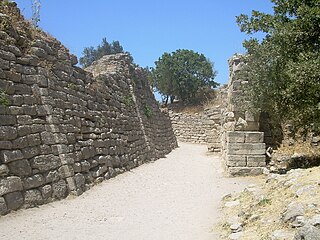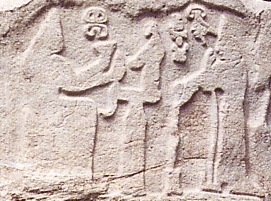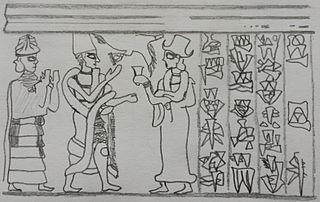
The Hittites were an Anatolian people who played an important role in establishing an empire centered on Hattusa in north-central Anatolia around 1600 BC. This empire reached its height during the mid-14th century BC under Suppiluliuma I, when it encompassed an area that included most of Anatolia as well as parts of the northern Levant and Upper Mesopotamia.

Mitanni, also called Hanigalbat or Hani-Rabbat in Assyrian or Naharin in Egyptian texts, was a Hurrian-speaking state in northern Syria and southeast Anatolia from c. 1500 to 1300 BC. Mitanni came to be a regional power after the Hittite destruction of Amorite Babylon and a series of ineffectual Assyrian kings created a power vacuum in Mesopotamia.

Yamhad was an ancient Semitic kingdom centered on Ḥalab (Aleppo), Syria. The kingdom emerged at the end of the 19th century BC, and was ruled by the Yamhadite dynasty kings, who counted on both military and diplomacy to expand their realm. From the beginning of its establishment, the kingdom withstood the aggressions of its neighbors Mari, Qatna and Assyria, and was turned into the most powerful Syrian kingdom of its era through the actions of its king Yarim-Lim I. By the middle of the 18th century BC, most of Syria minus the south came under the authority of Yamhad, either as a direct possession or through vassalage, and for nearly a century and a half, Yamhad dominated northern, northwestern and eastern Syria, and had influence over small kingdoms in Mesopotamia at the borders of Elam. The kingdom was eventually destroyed by the Hittites, then annexed by Mitanni in the 16th century BC.

The Troada or Troad, or Troas, is the historical name of the Biga Peninsula in the northwestern part of Anatolia, Turkey. This region now is part of the Çanakkale province of Turkey. Bounded by the Dardanelles to the northwest, by the Aegean Sea to the west and separated from the rest of Anatolia by the massif that forms Mount Ida, the Troad is drained by two main rivers, the Scamander (Karamenderes) and the Simois, which join at the area containing the ruins of Troy.

The Hattians were an ancient people who inhabited the land of Hatti in central Anatolia. The group was documented at least as early as the empire of Sargon of Akkad, until it was gradually absorbed c. 2000–1700 BC by the Indo-European Hittites, who were subsequently associated with the "land of Hatti".
Mursili II was a king of the Hittite Empire c. 1321–1295 BC.

Lugal is the Sumerian term for "king, ruler". Literally, the term means "big man." In Sumerian, lu "𒇽" is "man" and gal "𒃲" is "great," or "big."

Kussara (Kuššar) was a Bronze Age kingdom in Anatolia. The kingdom, though apparently important at one time, is mostly remembered as the origin of the dynasty that would form the Old Hittite Kingdom. The Kussaran king Pithana, with his son Anitta, forerunners of the later Hittite kings, conquered Kanesh (Nesa) and its important trade centrum in roughly 1780 BC. The seat of the Kussaran dynasty was then moved to Kaneš, though Kussara appears to have retained ceremonial importance. Anitta took the title of 'Great King' when he defeated the polities of Zalpuwa and Hattum. Pithana and Anitta are the only two recorded kings of Kussara, and their exploits are known chiefly from the so-called 'Anitta Text,' one of the earliest inscriptions in the Hittite language yet discovered. A further king, Labarna I is accepted as a king of Kussara by most scholars. Hattusili I, recognized as one of the first Hittite kings, referred to himself as 'man of Kussara,' but moved his capital from there to Hattusa. It is clear, however, that even after the capital was moved, Kussara retained some importance, as it was there that Hattusili would call a council on his own succession.
Hayasa-Azzi or Azzi-Hayasa was a Late Bronze Age confederation formed between two kingdoms of Armenian Highlands, Hayasa located South of Trabzon and Azzi, located north of the Euphrates and to the south of Hayasa. The Hayasa-Azzi confederation was in conflict with the Hittite Empire in the 14th century BC, leading up to the collapse of Hatti around 1190 BC.

Nerik was a Bronze Age settlement to the north of the Hittite capitals Hattusa and Sapinuwa, probably in the Pontic region. The Hittites held it as sacred to a Storm-god who was the son of Wurušemu, Sun-goddess of Arinna. The weather god is associated or identified with Mount Zaliyanu near Nerik, responsible for bestowing rain on the city.

Puduḫepa or Pudu-Kheba was a Hittite queen married to the King Hattusili III. She has been referred to as "one of the most influential women known from the Ancient Near East."
Huzziya II was a king of the Hittites. He was killed by Muwatalli I, who seized the throne and was possibly the Gal Mesedi of the royal bodyguard.

The Egyptian–Hittite peace treaty, also known as the Eternal Treaty or the Silver Treaty, is the only ancient Near Eastern treaty for which both sides' versions have survived. It is sometimes called the Treaty of Kadesh after the well-documented Battle of Kadesh fought some sixteen years earlier, although Kadesh is not mentioned in the text. Both sides of the treaty have been the subject of intensive scholarly study. The treaty itself did not bring about a peace; in fact "an atmosphere of enmity between Hatti and Egypt lasted many years," until the eventual treaty of alliance was signed.
The gal mesedi was a Hittite military and administrative title literally meaning "chief of the royal bodyguards". He was in charge of the Mesedi, the personal bodyguard of the Hittite king. It is considered to be one of the most important and prestigious posts of the Hittite Kingdom.
The gal gestin was a Hittite military and administrative title literally meaning "chief of the wine stewards". It is considered to be one of the most important and prestigious posts of the Hittite Kingdom.

Palistin, was an early Syro-Hittite kingdom located in what is now northwestern Syria and the southeastern Turkish province of Hatay. Its existence was confirmed by the discovery of several inscriptions mentioning Taita, king of Palistin.

The Yamhad dynasty was an ancient Amorite royal family founded in c. 1810 BC by Sumu-Epuh of Yamhad who had his capital in the city of Aleppo. Started as a local dynasty, the family expanded its influence through the actions of its energetic ruler Yarim-Lim I who turned it into the most influential family in the Levant through both diplomatic and military tools. At its height the dynasty controlled most of northern Syria and the modern Turkish province of Hatay with a cadet branch ruling in the city of Alalakh.
The House of Suhi was a dynasty of rulers of Carchemish. The members of this dynasty are best known to us through Hieroglyphic Luwian sources. Only one member of the house of Suhi is specifically mentioned in Assyrian sources. The House of Suhi was followed by a dynasty known as the House of Astiruwa.
Hartapu was a late Hittite king who reigned in Tarhuntassa in the 8th Century BCE. He is known from Hieroglyphic Luwian inscriptions from Kizildağ, Mount Karadağ, and Burunkaya near Aksaray. His recently discovered monumental stele claimed victory over the kingdom of Phrygia, ruled around that time by King Midas.